Yesterday’s rain may bring in, as well as promote, some more late season disease. I want to stress again that knowing what your pest problem is will help avoid it next year as well as perhaps get a handle on it this year. Sometimes it is easy to tell, sometimes I can help by just looking at a picture, and other times we have to send a sample up to the University of Maine Pest Management Office or an equivalent plant diagnostic laboratory. Do not spray materials unless you know that you have a problem for which the material is labeled and effective.
In this issue:
Late blight update
Rhizoctonia in brassica
Plectosporium blight
When to harvest winter squash
Basil Downy mildew update
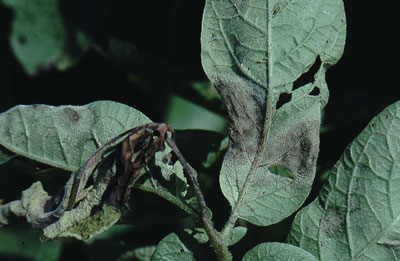 |
| Late blight |
Late blight is popping up in more places now, both on tomato and potatoes. I have gotten reports and seen samples of it in southern New Hampshire, as well as in south central, central and northern Maine. The rainy day yesterday probably helped it spread and get a foot hold in other sites. Be sure to scout your crops. If you believe you have late blight on either tomato or potato, you may send me or your local Extension educator photos. I suggest that you get some confirmation before you destroy any plants. I have sadly seen photos of early blight, septoria leaf spot, Botrytis, damage from leafhoppers and more that were sent to me AFTER folks pulled their plants thinking they had late blight.
Farmers who are spraying protective copper fungicides should continue to do so.
Gardeners who get a confirmed diagnosis should (on a sunny day), remove the infected plants, place in a plastic bag and discard in the trash or completely bury the plants deep enough so they cannot sprout. Why on a sunny day? That is because late blight spores are wimps and die quite quickly when exposed to sun, so any spores kicked up will die. Let’s hope for sunny days.
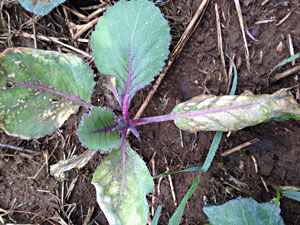 |
| Rhizoctonia solani affecting cabbage |
RHIZOCTONIA SOLANI IN BRASSICA
Rhizoctonia solani is a common soil born fungi. There are many strains of it that impact production of different crops, and many of these are specific to which crop they attack. The fungi overwinters as mycelium and sclerotia in the soil. The soil remains infested indefinitely. It is environmental and plant conditions that lead to infection. Rhizoctonia can infect plants directly through the cuticle or through wounds. It can cause damping off and wirestem in seedlings as well as head rot and bottom rot in mature plants. Recently I have been seeing midseason cabbage and other brassicas with pretty bad infections. This occurs in damp, warm conditions when the leaves touch the moist soil. Blackish sunken lesions form, initially on the underside of the leaves. Later the upper surface is impacted as well and the leaves become papery, especially when the weather changes to dry. Later the lower leaves yellow and die. Sometimes the plants recover, and sometimes, if the weather remains damp, the disease progresses and the whole head rots.
Anything you can do to avoid wet conditions will help. Avoid watering on cloudy days. Any stress promotes the disease, such as cold, hot, and deficiencies of calcium, potassium or nitrogen. But, be careful because excess nitrogen also seems to promote the disease.
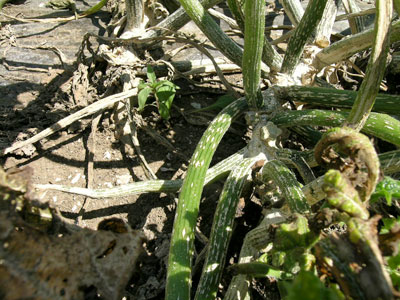 |
| Plectosporium on zucchini stems |
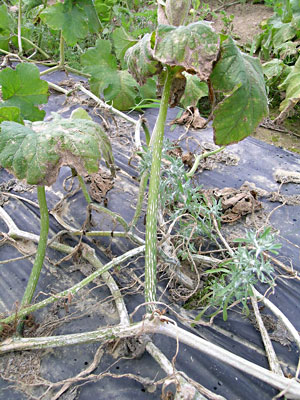 |
| Plectosporium on pumpkin vines |
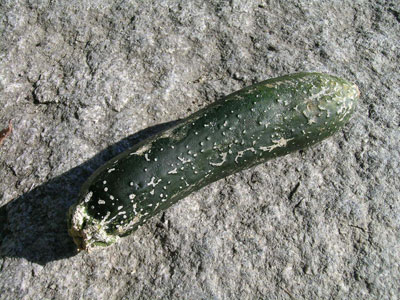 |
| Plectosporium on zucchini fruit |
PLECTOSPORIUM BLIGHT [ON ZUCCHINI]
(Modified from a report by T. Jude Boucher, University of Connecticut, Cooperative Extension System)
Plectosporium blight, caused by the fungus Plectosporium tabacinum (formerly known as Microdochium tabacinum), is a relatively new destructive disease of cucurbits in New England. This disease was found in Tennessee in 1988 and has since spread rapidly throughout the eastern United States. It occurred on a single farm in Massachusetts in 2000 and on at least a dozen farms in Connecticut and Massachusetts in 2003. In the fall of 2004, after two seasons of rainy weather, it was present in every field Jude visited from Long Island Sound to Burlington, Vermont. I see it every wet season, and I am now seeing it again this wet season, especially on zucchini.
Plectosporium blight is known to cause damage to a wide variety of cucurbit crops in Europe and Asia, but the strain present in the U.S. seems to primarily damage pumpkins, summer squash, zucchini and a few varieties of gourds. In wet years, which favor disease development and spread, crop losses in no-spray and low-spray fields can range from 50 to 100%.
This disease is easily recognized but is difficult for organic growers to manage. If you spot it, be prepared to implement good sanitation and develop an effective crop rotation of your cucurbits to clean fields next season.
Description and Management
The clearest symptom to look for on vines and petioles are white lesions that tend to be diamond to lens-shaped; and on fruit and leaves the lesions are usually round and white.
Plectosporium blight is favored by cool, rainy weather. The fungus can overwinter on crop residue and thus can persist in the soil for several years. Plectosporium has not been reported to be seed-borne. Tiny, one or two-celled, sickle-shaped spores are formed in lesions on vines, stems, fruit, leaves and leaf petioles. Spores are dispersed by wind over long distances. Lesions are small (<1/4 inch) and white. The lesions increase in number and coalesce until most of the vines and leaf petioles turn white and the foliage dies. Severely infected pumpkin vines become brittle and will shatter if stepped on. Early in the infection cycle, foliage tends to collapse in a circular pattern before damage becomes more universal throughout the field. These circular patterns can be easily detected when viewing an infected field from a distance. Numerous fruit lesions produce a white russeting on the surface and stems that render the fruit unmarketable. Fruit lesions also allow for entry of soft rot pathogens that hasten the destruction of the crop.
Disease management recommendations include:
- a 2-3 year crop rotation
- planting in sites with good air circulation to encourage rapid drying of the foliage
- switching to trickle irrigation if you have been using overhead
- scouting fields to confirm the presence of Plectosporium, and plowing under crop residue after harvest
- Although there are some fungicides for conventional growers the fungicides available to organic growers are not thought to offer adequate control.
WINTER SQUASH LOOKS READY, SHOULD I HARVEST?
Winter squash look ready to harvest before they actually are mature. It is important to wait for maturity to have maximum storage and best eating quality. Most squash varieties reach full size by 20 days after fruit set. Accumulation of starch and other dry matter peaks at about 30-35 days after fruit set. But, the fruit is not fully mature until the seeds are fully developed, which occurs about 55 days for butternut. This is different for other varieties. If you would like to read more, take a look at this article by Brent Loy, the very well known plant breeder at the University of New Hampshire.
Or, here is a summary put together by the folks at Johnny’s Selected Seeds
Harvest and Storage
A critical factor in eating quality is maturity of the squash when it is harvested. Most small varieties reach full size by 20 days after fruit set. Accumulation of dry matter and starch content peaks at 30 to 35 days after pollination. However, the fruit is not mature until the seeds are fully developed, which occurs about 55 days after fruit set.
Dr. Loy stresses the importance of maintaining healthy plants until at least 50 days after fruit set because photosynthesis is essential to the development of sugars and dry matter. A squash that is picked too early will continue to develop seeds, but it does so by depleting the dry matter, thereby reducing eating quality.
Although fruit and seed maturity are similar across the three main species of edible winter squashes and pumpkins, harvest and storage recommendations vary by type.
Cucurbita maxima | Kabocha, Hubbard, and Buttercup Squashes
Kabocha, hubbard, and buttercup (C. maxima) varieties should be harvested before complete seed maturation, at about 40 to 45 days after fruit set, when the fruit is still bright. That’s when the rind is hardest, so less likely to be damaged in storage. They also are susceptible to sunburn as the vines die down, so it’s best to get them harvested and out of direct sun before then to prevent the rind from turning brown or, with extreme sunburn, white. Kabocha squash have a high dry matter content and small seed cavity, so seed maturation off the vine is not a problem. However, once harvested, they should be stored at room temperature for 10 to 20 days to allow sugars to reach acceptable levels.
C. pepo | Acorn Squash, most Pie Pumpkins
Acorn squash (C. pepo) are misleading because they reach full size and develop a dark green-to-black mature color about two weeks after fruit set – 40 to 50 days before they should be harvested. Dr. Loy says that a better way to judge maturity is to look at the rind where it touches the ground. Immature squash have a light green or light yellow ground color, whereas mature squash have a dark orange ground color. Immature acorn squash have low sugar levels and although they will develop sweetness after harvest, they do so by depleting the dry starchy matter to convert it to sugars. This means storage life is shortened and eating quality declines.
C. moschata | Butternut Squash, some Pie Pumpkins
Butternut squash (C. moschata) are easier to judge by sight because they don’t acquire their characteristic tan color until late in development, 35 days or more after fruit set. If the weather stays frost-free, they should be allowed to remain on the plants until 55 days after fruit set. In short-season areas, they often are harvested soon after turning tan because of the risk of frost damage. At that point, however, the sugars have not elevated to the 11% required for good flavor, so butternut squash harvested at 55 days after fruit set should be stored for 60 days at 56-60°F/10-16°C, with relative humidity between 50 and 70%. Carotenoid content also increases in storage, making the butternut squash more nutritious after it’s been stored for a couple of months. To accelerate maturity and increase sweetness, Dr. Loy has found that butternuts held at warm temperatures (up to 85°F/29°C) for two weeks develop acceptable levels of sugars.
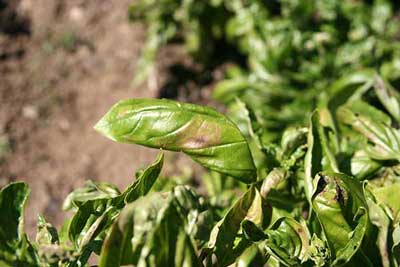 |
| Basil downy mildew |
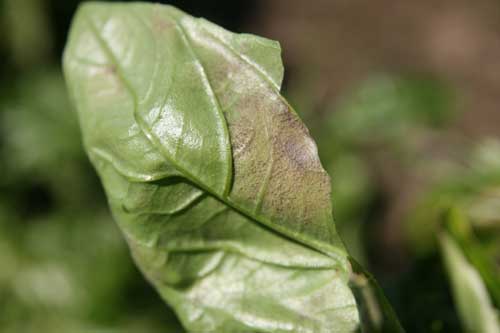 |
| Basil downy mildew on the underside of a basil leaf |
This is a pretty new problem, and it is all of a sudden widespread. This year it seems to be spotty. I have received many photos from farmers and gardeners around New England, but have none yet on my farm. Downy mildew of basil was first reported in Uganda back in 1930. Recently it has been getting lots of attention as it spreads, first to Italy in 2004, France in 2005, United States (Florida) in 2007 and by 2009 New England.
The first symptom is a pale yellowing of the upper surface of the leaves, quite similar to sunscald. Later, vein-bounded patches of dark spore production can be seen on the lower surface. This develops into a gray, fuzzy growth typical of downy mildews of other crops. At first you may be able to convince yourself that some soil has been splashed onto the underside of the leaf, but soon the plants will be going down and it will be clear that it is not a problem that can be washed away.
The disease may be seed borne, but that is probably a very rare event. The spread in most likely do to the wind blown spores. In the damp conditions of the early and mid summer they could move far and wide. There is also some belief that seedlings already infected and moved across country for sale play a role. And this year some of the big box stores were selling plants already infected. I bet that is playing a role in the spotty outbreaks.
The infected leaves are safe to eat, and I have a report from a grower that mildly infected leaves still made a fine tasting pesto. Some types of basil are less or not susceptible at all. For example, my Thai basil is fine. I have heard from a grower that the lemon basil is not susceptible, and that the purple basil seems a bit less susceptible. The common sweet basil is the most susceptible. If you have this problem, and you grow more than one type of basil, please keep records and let me know if you see any resistance so we can make some recommendations for next year. I have heard that Dolly is very susceptible and went down even though the other sweet basil varieties in the field were fine. The folks at Johnnys and lots of others are working hard to get resistant varieties. For now, if you see downy mildew on the variety you are growing, make pesto fast.
There are relatively few fungicides labeled for herbs. Also, I have not seen reports of efficacy of any. Some copper fungicides are labeled. Other OMRI listed products that are labeled for herbs include Actinovate AG, Trilogy, and OxiDate. But, again, I do not have any evidence that they are effective. If you try any of these, leave some plants untreated so we can get some information.
For now, anything that will make the leaves dry quickly will help, e.g., weed control, good spacing, venting tunnels, watering in the morning instead of the evening, etc.
